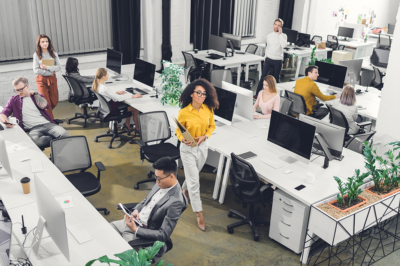Everything has shifted in light of COVID-19, and the pursuit of workplace wellness will accelerate.
Deemed a global ‘pandemic’ by the World Health Organisation (WHO) on 11 March 2020, COVID-19 has grown to affect countries, companies and individuals across geographies. It is widely known that control of our everyday environments has a direct impact on our health and well-being — now more evident and important than ever — and the workplace must adapt in the short-and long-term.
In our regular series identifying COVID-19 recommendations for occupiers (see our global Knowledge Leader resource and APAC microsite), we are pleased to highlight what impacts the global drive for healthier environments is having and how occupiers can start to take action to deliver wellness for your people to #BeatTheVirus now and for long-term benefits.
Compared to projections of the gradual, continual integration of wellness at the start of the year, wellness in the workplace has taken a different direction, as it accelerates in priority. Though we will no doubt see further changes as the year goes on and impacts are felt at different speeds globally, the focus now and for the foreseeable future is twofold:
- Business continuity and preparedness: How do businesses operate effectively, working remotely or in split operations, and preparation to negate future disruptions?
- Well-being of employees: How do businesses take measures to keep employees safe, healthy and productive?
Business Continuity and Preparedness
As detailed in our previous report ‘How, Where, WELL!’, wellness in the workplace has shifted from a corporate social responsibility consideration to a strategic priority in recent years. As we see workers in Asia Pacific cautiously returning to offices after countries stabilise and restart industries, COVID-19 infection rates are continuing to rise globally, travel is largely suspended everywhere, and it is clear that the operating environment has changed. Wellness is quite simply a personal and commercial imperative.
Without healthy buildings and spaces, employee well-being is compromised. Without clear action and communication, trust is eroded. Without healthy employees, businesses fail to operate effectively. The businesses who will prosper will be those who adapt best — those who invest in wellness and health-focused environments, communicate changes proactively and effectively, and support well-being, engagement and personal care for their people.
Well-prepared businesses can help protect their employees and their bottom lines. For effective business continuity, organisations should prepare for continuity through part-or wholly enabled remote workforces and, when possible, resuming business operations whilst limiting the chance of the virus spreading. Priorities will be focused on reassuring and educating employees in how to work well at home, whilst ensuring and maintaining a healthy workplace to return to.
Well-Being of Employees
‘If managed poorly, [buildings] can spread disease. But if we get it right, we can enlist our schools, offices and homes in this fight’ – NYTimes
To achieve the above, we have identified five key areas for tenants and landlords to consider:
- Space in the fight against the virus
- Boosting immunity
- Managing air quality
- Preparing for disruption
- Managing stress
- Space in the fight against the virus [Immediate]
(Promoting hygiene and socially responsible behaviour)
Implement and promote commonsense strategies to ensure all are aware and equipped to execute them. The importance of hand washing, cleanliness, and good hygiene practices are imperative for all.
- Don’t go to work if you are unwell. Whether COVID-19 or other illness, the office is not the place to be. Stay home, get better and then return to work.
- Within a building or office, ensure high-touch surfaces are frequently cleaned. Regularly sanitise elevator buttons, door handles, common area surfaces, meeting rooms tables, reception areas and workstations to minimise risk.
- Provide adequate sink space (see WELL Building Standard guidance) to allow adequate space for essential hand washing, minimizing risk of contact or contamination.
- Provide soap and paper towels or hand dryers.
- Ensure there is appropriate signage and educational material providing guidance on hand washing, drying and hygiene standards.
- Boosting Immunity [Near-term]
“Your body’s first line of defence against infectious disease is your immune system” – Richard Carmona, 17th Surgeon General of the United States
Now is the ideal time to address well-being at both an individual and organizational level. We need to focus on building a strong immune system, and encourage healthy lifestyles through healthy eating, physical exercise and mindful activities.
- Offer on-site fitness activities, with limited number of attendees adhering to social distancing requirements.
- Where on-site is not possible, activate online platforms or establish a corporate membership providing free or subsidies access to employees.
- Subsidized healthy meals/snacks in the office and prioritising individual portions. As discussed in our COVID-19 article for Flexible Workspace, it is recommended to discontinue central buffet-style catering.
- Host competitions for movement like step challenges or activities in the home.
- Bring in healthy food and beverage providers or provide discounts for deliveries of healthy food options.
- Space and amenities for food production on site, with a focus on hygiene and cleanliness.
- Bring in experts to run workshops focused on nutrition.
- Provide educational resources on nutrition and immunity.
- Managing Air Quality / Ensuring Clean Air [Near to mid-term]
The WHO warns that “poorly ventilated buildings affect air quality and can contribute to the spread of disease.” Yet, proper ventilation, filtration and humidity levels can help to reduce the spread of pathogens. Certain measures can be taken by both building operators and tenants to mitigate the risk.
- Maximise ventilation: Bring in more outdoor air via building fresh air system or open windows (if possible). PureLiving, a major air quality expert, suggests targeting 30 cubic meters per hour per person or keeping co2 levels less than 1,000 parts per million.
- Increase ventilation systems to 100% fresh air and on maximum speed.
- Implement UV or ionization to inactivate viruses caught on filters.
- Try to restrict the use of recirculated air especially between offices
- Increase relative humidity targeting 50-65% relative humidity, as there is evidence that viruses survive better at low humidity.
4. Preparing for disruption [Mid-term]
Disruption comes in many forms, and COVID-19 is the latest curve ball to ‘business as usual.’ This health crisis has demonstrated the urgent need to prepare spaces and operations to measure, monitor and adapt quickly. International guidelines focused on incorporating health into the built environment can be a good starting point — consider some of the following:
- Regularly monitor indoor environmental quality (IEQ): Install monitors to check humidity, temperature, co2, air particulate matter at less than 2.5 micrometers and ATP levels. Review these regularly to ensure IEQ is within required thresholds.
- Leverage technology: Use online platforms to enable working flexibly and increase adaptability.
- Establish clear parameters to working remotely: Make it easy for people to connect and access information as needed.
- Invest in non-hazardous cleaning products and create rigorous cleaning protocols for ongoing use. Ensure sources of potential indoor pollutants —such as the mail room —are clearly separated with self-closing doors or ventilation to protect your space and people
- Reducing stress
The changes to people’s daily lives, and isolation measures currently in place across many countries, can lead to emotional stress (both work and non-work related), as we experience disruption from normal routines and colleague interactions. These conditions are essentially an area for change management in the following areas:
- Connectivity and continuity: Reduce the impact of social isolation by keeping connected. Technology and behaviour both have a key role to play to ensure success.
- Communicate: Be transparent at all times and keep information clear and concise to achieve business continuity. Avoid ambiguity, which can contribute to increased stress levels and poor performance
- Provide ergonomic guidelines at home or alternative workplace to reduce the incidence of musculoskeletal issues and poor posture, which can lead to injuries.
- Put mental health on the agenda: Provide access to mental health information, such as employee assistance programs
- Invest in stress reduction training for employees and make it easily accessible for all
- Activate or create internal wellness programs and create ambassadors for health and well-being.
The effects of COVID-19 are highlighting the importance of wellness and we now project that integration of wellness-focused ways of working will accelerate as the norm. Looking forward, we are optimistic that improved health and wellness practices, paired with the global response to the virus, will overcome current challenges.
Take action now, and work with Colliers experts and your landlords to action meaningful change. Employees will be looking for reassurance from you that they are being protected and that the business is prepared to look after them now and for the future.
About the Author:
Victoria Gilbert leads Colliers’ Wellness Consulting within Workplace Advisory for occupiers throughout the Asia Pacific market. As a highly experienced sustainability and wellness consultant, and formerly with the International WELL Building Institute leading the expansion of the WELL Building Standard in Asia Pacific, Victoria works with multinational companies and property developers alike – putting people at the heart of real estate.

 Colliers Insights Team
Colliers Insights Team
 Chris Zlocki
Chris Zlocki
 Adam Schindler
Adam Schindler